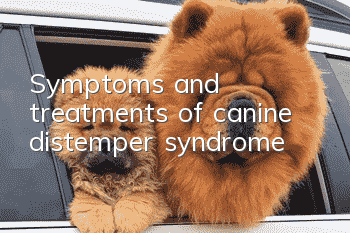Symptoms and treatments of canine distemper syndrome

Dogs can easily get canine distemper after being infected by the virus, and canine distemper is also a very contagious infectious disease. Once a dog gets canine plague, it will have symptoms such as fever, very low energy, inability to eat, diarrhea, cold, runny nose, sneezing and other symptoms in the early stage. In the middle stage, the body temperature will become higher, nasal discharge and eye mucus will appear. It also became turbid and coughed. In the late stages, I began to sleep more and became less energetic. Twitching of limbs, vomiting, diarrhea, until death. Some dogs can recover after being treated for canine distemper, but they are prone to leaving various sequelae.
1. Symptoms of canine plague sequelae
The virus carried by canine distemper can easily damage the brain and nervous system of dogs. Some dogs will have unsteady walking, frequent twitching of limbs, foaming at the mouth, drooling, head shaking, spinning in circles, and poor chewing ability. The standing posture becomes very weird, the hind limbs become difficult to use, epilepsy and other sequelae of dog plague occur.
Some canine distemper viruses can also cause damage to the dog's eyes, causing the cornea to turn white, causing keratitis or conjunctivitis. Some more severe cases may also cause perforation or blindness in the eyes, which can lead to symptoms such as pneumonia and enteritis.
2. Dog DistemperTreatment Methods
The sequelae of canine distemper are difficult to cure. Some of them will last a lifetime. You can only take good care of them in the later period. Usually, you often feed your dog some calcium tablets and vitamin B complex tablets. If your dog's nerves are severely damaged, you can give it to your dog every day. Angong Niuhuang Pills are very effective in treating epilepsy symptoms. Usually, it can also be combined with globulin injection and interferon treatment, and the effect will be better.
Supplementing your dog with various rich nutrients every day will be beneficial to the dog’s recovery, so that the bones can recover better. Proper exposure to the sun at ordinary times will also be of great help to the body’s recovery.
The above is an introduction to the symptoms and treatment methods of the sequelae of canine distemper. If the dog at home has contracted canine distemper and has the sequelae described in the article, the owners can treat the dog according to the treatment methods in the article!
- What should I do if my dog has no milk? The owner should check quickly and don’t let the puppies starve to death.
- Dog’s anal gland odor, please note that this is a sign of your dog’s health!
- How to make your dog like to eat dog food Four ways to make your dog fall in love with dog food
- Can dogs digest peach pits if they eat them? Can dogs digest peach pits if they accidentally eat them?
- How to protect your dog’s food? Teach you tips on training your dog
- Why do dogs defecate everywhere? How can dogs stop defecating everywhere?
- What should I do if my dog has lupus? Immune system diseases should not be underestimated
- If your dog's hair is cut and the skin is cut, the flesh is exposed. If the dog's hair is accidentally cut and the skin is cut, it must be disinfected immediately.
- Do dogs need deworming in summer? What should you pay attention to when raising dogs in summer?
- What to do if your dog has indigestion? Dog indigestion is no small matter!



